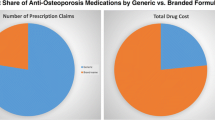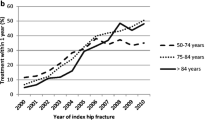Abstract
Summary
Osteoporosis medicines reduce osteoporotic fractures. There is a very strong negative correlation between the consumption of medicines and the price of an average daily dose indicating that affordability is a key factor that could increase consumption of antiosteoporotic medicines and, through that, reduce fractures.
Purpose
Osteoporosis is a major cause of morbidity and mortality in the modern world. Our study aims to describe the trends in incidence of hip fractures in relation to drug utilization patterns and the average price of antiosteoporotic medicines in Estonia.
Methods
Data on hip fractures was obtained from the medical claims database of Estonian Health Insurance Fund (EHIF). Consumption and price data was obtained from the Estonian State Agency of Medicines (SAM).Consumption is presented using WHO defined daily doses methodology, and the prices reflect the average wholesale price of medicines.
Results
From 2004 to 2010 there was a non-significant increasing trend in standardized hip fracture incidence in Estonia, but from 2010 to 2015, the trend turned to a significant decrease of 4.5% per year. The consumption of osteoporosis medication increased significantly from 2004 to 2009 by yearly average of 41.2%. After 2009, the consumption levelled. On contrast, the average price of one daily dose of osteoporosis medication decreased significantly from 2004 to 2009 by 16.9% per year and the decrease also levelled after 2009. This gives a very strong negative correlation of −0.93 (p < 0.001) between the consumption of antiosteoporotic medication and the average price of a daily dose of medication during the study period.
Conclusions
The statistically significant decline of standardized incidence of hip fractures from 2010 onward could at least in part be the result of the high increase in consumption of antiosteoporotic medicines which in turn is strongly negatively correlated with the average price of osteoporosis medicines.



Similar content being viewed by others
References
Cummings S, Kelsey J, Nevitt M, O’Dowd K (1985) Epidemiology of osteoporosis and osteoporotic fractures. Epidemiol Rev:178–208
Ström O, Borgstrom F, Zethraeus N et al (2008) Long-term cost and effect on quality of life of osteoporosis-related fractures in Sweden. Acta Orthop 79:269–280. doi:10.1080/17453670710015094
Borgström F, Lekander I, Ivergård M et al (2013) The International costs and utilities related to osteoporotic fractures study (ICUROS)—quality of life during the first 4 months after fracture. Osteoporos Int J Establ Result Coop Eur Found Osteoporos Natl Osteoporos Found USA 24:811–823. doi:10.1007/s00198-012-2240-2
Silverman SL, Schousboe JT, Gold DT (2011) Oral bisphosphonate compliance and persistence: a matter of choice? Osteoporos Int J Establ Result Coop Eur Found Osteoporos Natl Osteoporos Found USA 22:21–26. doi:10.1007/s00198-010-1274-6
Cummings SR, Melton LJ (2002) Epidemiology and outcomes of osteoporotic fractures. Lancet 359:1761–1767. doi:10.1016/S0140-6736(02)08657-9
Diez-Perez A, Adachi JD, Agnusdei D et al (2012) Treatment failure in osteoporosis. Osteoporos Int J Establ Result Coop Eur Found Osteoporos Natl Osteoporos Found USA 23:2769–2774. doi:10.1007/s00198-012-2093-8
Kanis JA, McCloskey EV, Johansson H et al (2013) European guidance for the diagnosis and management of osteoporosis in postmenopausal women. Osteoporos Int J Establ Result Coop Eur Found Osteoporos Natl Osteoporos Found USA 24:23–57. doi:10.1007/s00198-012-2074-y
Cooper C, Cole ZA, Holroyd CR et al (2011) Secular trends in the incidence of hip and other osteoporotic fractures. Osteoporos Int 22:1277–1288. doi:10.1007/s00198-011-1601-6
Ballane G, Cauley JA, Luckey MM, Fuleihan GE-H (2014) Secular trends in hip fractures worldwide: opposing trends east versus west: SECULAR TRENDS IN HIP FRACTURES WORLDWIDE. J Bone Miner Res 29:1745–1755. doi:10.1002/jbmr.2218
Alves SM, Economou T, Oliveira C et al (2013) Osteoporotic hip fractures: bisphosphonates sales and observed turning point in trend. A population-based retrospective study Bone 53:430–436. doi:10.1016/j.bone.2012.12.014
Fisher AA, O’Brien ED, Davis MW (2009) Trends in hip fracture epidemiology in Australia: possible impact of bisphosphonates and hormone replacement therapy. Bone 45:246–253. doi:10.1016/j.bone.2009.04.244
Fisher A (2010) Bisphosphonate use and hip fracture epidemiology: ecologic proof from the contrary. Clin Interv Aging 355. doi:10.2147/CIA.S13909
Borrescio-Higa F (2015) Can Walmart make us healthier? Prescription drug prices and health care utilization. J Health Econ 44:37–53. doi:10.1016/j.jhealeco.2015.07.005
Jürisson M, Vorobjov S, Kallikorm R et al (2015) The incidence of hip fractures in Estonia, 2005–2012. Osteoporos Int 26:77–84. doi:10.1007/s00198-014-2820-4
Hiligsmann M, Bruyère O, Roberfroid D et al (2012) Trends in hip fracture incidence and in the prescription of antiosteoporosis medications during the same time period in Belgium (2000-2007): hip fracture incidence and change in antiosteoporosis medications. Arthritis Care Res 64:744–750. doi:10.1002/acr.21607
Haleem S, Lutchman L, Mayahi R et al (2008) Mortality following hip fracture: trends and geographical variations over the last 40 years. Injury 39:1157–1163. doi:10.1016/j.injury.2008.03.022
WHO Collaborating Centre for Drug Statistics Methodology. http://www.whocc.no. Accessed 3 Nov 2016
Statistics Estonia. http://www.stat.ee/en. Accessed 3 Nov 2016
Reginster JY, Neuprez A, Dardenne N et al (2014) Efficacy and safety of currently marketed anti-osteoporosis medications. Best Pract Res Clin Endocrinol Metab 28:809–834. doi:10.1016/j.beem.2014.09.003
Estonian State Agency of Medicines website. www.ravimiamet.ee/en. Accessed 3 Nov 2016
Kim H-J, Fay MP, Feuer EJ et al (2000) Permutation tests for joinpoint regression with applications to cancer rates. Stat Med 19:335–351
Hernlund E, Svedbom A, Ivergård M, et al (2013) Osteoporosis in the European Union: medical management, epidemiology and economic burden. A report prepared in collaboration with the International Osteoporosis Foundation (IOF) and the European Federation of Pharmaceutical Industry Associations (EFPIA). Arch Osteoporos 8:136. doi: 10.1007/s11657-013-0136-1
Abrahamsen B, Vestergaard P (2010) Declining incidence of hip fractures and the extent of use of anti-osteoporotic therapy in Denmark 1997–2006. Osteoporos Int 21:373–380. doi:10.1007/s00198-009-0957-3
Larsson TJ, Hägvide M-L, Svanborg M, Borell L (2010) Falls prevention through community intervention—a Swedish example. Saf Sci 48:204–208. doi:10.1016/j.ssci.2009.08.002
Health statistics and health research database. http://pxweb.tai.ee/esf/ pxweb2008/dialog/statfile1.asp. Accessed 9 Jan 2017
Sabaté E (2003) Adherence to long-term therapies: evidence for action. World Health Organization, Geneva
(2008) Osteoporosis in the European Union in 2008: Ten years of progress and ongoing challenges. International Osteoporosis Foundation
Hansen C, Pedersen BD, Konradsen H, Abrahamsen B (2013) Anti-osteoporotic therapy in Denmark—predictors and demographics of poor refill compliance and poor persistence. Osteoporos Int J Establ Result Coop Eur Found Osteoporos Natl Osteoporos Found USA 24:2079–2097. doi:10.1007/s00198-012-2221-5
Svedbom A, Hernlund E, Ivergård M et al (2013) Osteoporosis in the European Union: a compendium of country-specific reports. Arch Osteoporos 8:137. doi:10.1007/s11657-013-0137-0
Author information
Authors and Affiliations
Corresponding author
Ethics declarations
Conflicts of interest
None.
Funding source
This work was supported by institutional research funding IUT 20–46 of the Estonian Ministry of Education and Research.
Rights and permissions
About this article
Cite this article
Laius, O., Pisarev, H., Maasalu, K. et al. Trends in and relation between hip fracture incidence and osteoporosis medication utilization and prices in Estonia in 2004–2015. Arch Osteoporos 12, 48 (2017). https://doi.org/10.1007/s11657-017-0341-4
Received:
Accepted:
Published:
DOI: https://doi.org/10.1007/s11657-017-0341-4




